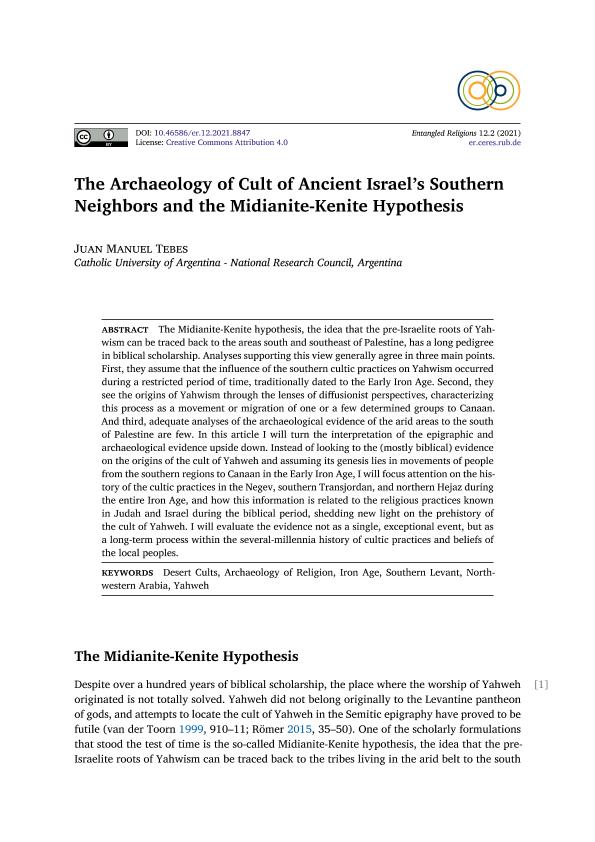Mostrar el registro sencillo del ítem
dc.contributor.author
Tebes, Juan Manuel

dc.date.available
2022-08-11T12:36:03Z
dc.date.issued
2021-03
dc.identifier.citation
Tebes, Juan Manuel; The archaeology of cult of ancient Israel’s southern neighbors and the Midianite-Kenite hypothesis; Ruhr-Universität Bochum. Center for Religious Studies; Entangled Religions; 12; 2; 3-2021; 1-35
dc.identifier.issn
2363-6696
dc.identifier.uri
http://hdl.handle.net/11336/165125
dc.description.abstract
The Midianite-Kenite hypothesis, the idea that the pre-Israelite roots of Yahwism can be traced back to the areas south and southeast of Palestine, has a long pedigree in biblical scholarship. Analyses supporting this view generally agree in three main points. First, they assume that the influence of the southern cultic practices on Yahwism occurred during a restricted period of time, traditionally dated to the Early Iron Age. Second, they see the origins of Yahwism through the lenses of diffusionist perspectives, characterizing this process as a movement or migration of one or a few determined groups to Canaan. And third, adequate analyses of the archaeological evidence of the arid areas to the south of Palestine are few. In this article I will turn the interpretation of the epigraphic and archaeological evidence upside down. Instead of looking to the (mostly biblical) evidence on the origins of the cult of Yahweh and assuming its genesis lies in movements of people from the southern regions to Canaan in the Early Iron Age, I will focus attention on the history of the cultic practices in the Negev, southern Transjordan, and northern Hejaz during the entire Iron Age, and how this information is related to the religious practices known in Judah and Israel during the biblical period, shedding new light on the prehistory of the cult of Yahweh. I will evaluate the evidence not as a single, exceptional event, but as a long-term process within the several-millennia history of cultic practices and beliefs of the local peoples.
dc.format
application/pdf
dc.language.iso
eng
dc.publisher
Ruhr-Universität Bochum. Center for Religious Studies
dc.rights
info:eu-repo/semantics/openAccess
dc.rights.uri
https://creativecommons.org/licenses/by/2.5/ar/
dc.subject
ARCHAEOLOGY OF RELIGION
dc.subject
DESERT CULTS
dc.subject
IRON AGE
dc.subject
NORTHWESTERN ARABIA
dc.subject
SOUTHERN LEVANT
dc.subject
YAHWEH
dc.subject.classification
Otras Historia y Arqueología

dc.subject.classification
Historia y Arqueología

dc.subject.classification
HUMANIDADES

dc.title
The archaeology of cult of ancient Israel’s southern neighbors and the Midianite-Kenite hypothesis
dc.type
info:eu-repo/semantics/article
dc.type
info:ar-repo/semantics/artículo
dc.type
info:eu-repo/semantics/publishedVersion
dc.date.updated
2022-08-09T17:32:29Z
dc.journal.volume
12
dc.journal.number
2
dc.journal.pagination
1-35
dc.journal.pais
Alemania

dc.journal.ciudad
Bochum
dc.description.fil
Fil: Tebes, Juan Manuel. Consejo Nacional de Investigaciones Científicas y Técnicas; Argentina. Pont. Universidad Catolica Arg."sta.maria de Los Bs.as.". Facultad de Cs. Sociales, Politicas y de la Comunicación. Instituto de Investigaciones; Argentina
dc.journal.title
Entangled Religions
dc.relation.alternativeid
info:eu-repo/semantics/altIdentifier/doi/https://doi.org/10.46586/er.12.2021.8847
dc.relation.alternativeid
info:eu-repo/semantics/altIdentifier/url/https://er.ceres.rub.de/index.php/ER/article/view/8847
Archivos asociados
